The chapter on irrigation management of citrus is largely taken from guidelines on trees prior to citrus greening, provided in chapter 9 of Nutrition of Florida Citrus Trees. A section has been added to cover recent findings on water use of trees affected by citrus greening and the impact this has on irrigation management considerations.
Water Supply
Water is a limiting factor in Florida citrus production during the majority of the year because of the low water-holding capacity of our sandy soils and the nonuniform distribution of rainfall. In Florida, the major portion of rainfall occurs from June through September, but rainfall is usually scarce from February to May. The latter period coincides with the critical stages of leaf expansion, flowering, fruit set, fruit enlargement, and the onset of natural fruit drop in late-maturing varieties, and additional irrigation is necessary to reduce the negative effects of water stress. Adequate irrigation management is key to optimize water use and increase crop yield. Diurnal fluctuations of water use need to be considered because they result in variation in fruit retention and percent juice content. Several weather-, soil-, and plant-based methods are available for irrigation management. The most-used methods rely on weather stations to calculate evapotranspiration (ET), which is the combination of water lost by plant transpiration and removal of water from soils and wet surfaces by evaporation, and soil moisture (SM), which indicates the water availability status of the soil for plant uptake.
Allowable Soil Water Depletion
As soil dries out, water becomes increasingly difficult for trees to uptake, which can eventually cause water stress. Tree health and yield will suffer if the soil is allowed to get too dry. Before huanglongbing (HLB) was found in Florida in 2005, it was recommended that maximum soil water depletion should not exceed 25% to 33% of available water from February to June to provide adequate water for flowering, fruit set, and vegetative growth. Once the rainy season starts, recommendations stated that maximum depletion could be increased to 50% to 66%. This additional allowable depletion increases the capacity of the soil to hold rainfall without leaching nutrients or any soil-applied chemicals. The same depletion in the fall and winter months will save water without reduction in yield. The soil water depletion of the available soil water is calculated as the difference between moisture contents at field capacity and permanent wilting point. Field capacity is the water content at which the initial rapid gravity drainage ceases or becomes negligible, considered as 10 centibar for sandy soils. The permanent wilting point is considered the soil water content at 15 bar (or 1500 centibar; a higher number means drier soil condition). Under Florida conditions, field capacity is assumed to be in the range of 8% to 12%, and wilting point is assumed to be 2% to 3%. Research has shown that water uptake by healthy citrus trees declines as the soil dries, resulting in less than half as much water being taken up at an available water content of about 50%. Recent research has further indicated that distributing irrigation across the week with more frequency and less volume increases water use efficiency and improves water uptake by HLB-affected trees, thus improving yield. For example, if 3 hours/week of water are required, irrigation should be distributed in daily 30-minute applications for five days.
Irrigation Scheduling
Current UF/IFAS citrus irrigation recommendations estimate citrus tree water requirements for mature trees based on data collected prior to the introduction of HLB into Florida. Citrus trees affected by HLB are known to lose substantial foliage and root mass depending on disease severity, thus negatively influencing water and nutrient uptake.
The commonly used methods of irrigation management include water budgeting, soil water measurement, and smartphone apps. These irrigation scheduling methods will be discussed in the following sections.
Water Budgeting
Experience or the calendar method can provide a reasonably good irrigation schedule but are not accurate enough to maximize water-use efficiency and prevent nutrient leaching. The calendar method of irrigation scheduling requires the user to obtain daily evapotranspiration (ET) from weather data sources such as the Florida Automated Weather Network (FAWN), accessible at https://fawn.ifas.ufl.edu. The daily ET is then multiplied by a crop coefficient (Kc) based on the time of year (Figure 1) to determine daily estimated water loss. This amount is then subtracted from the estimated soil moisture from the previous day. Reference ET and convenient irrigation scheduling management tools for all Florida citrus production regions can be found on the FAWN website mentioned above, and a description of its use can be found at https://crec.ifas.ufl.edu/media/crecifasufledu/extension/extension-publications/2015/2015_March_grower_tools.pdf.
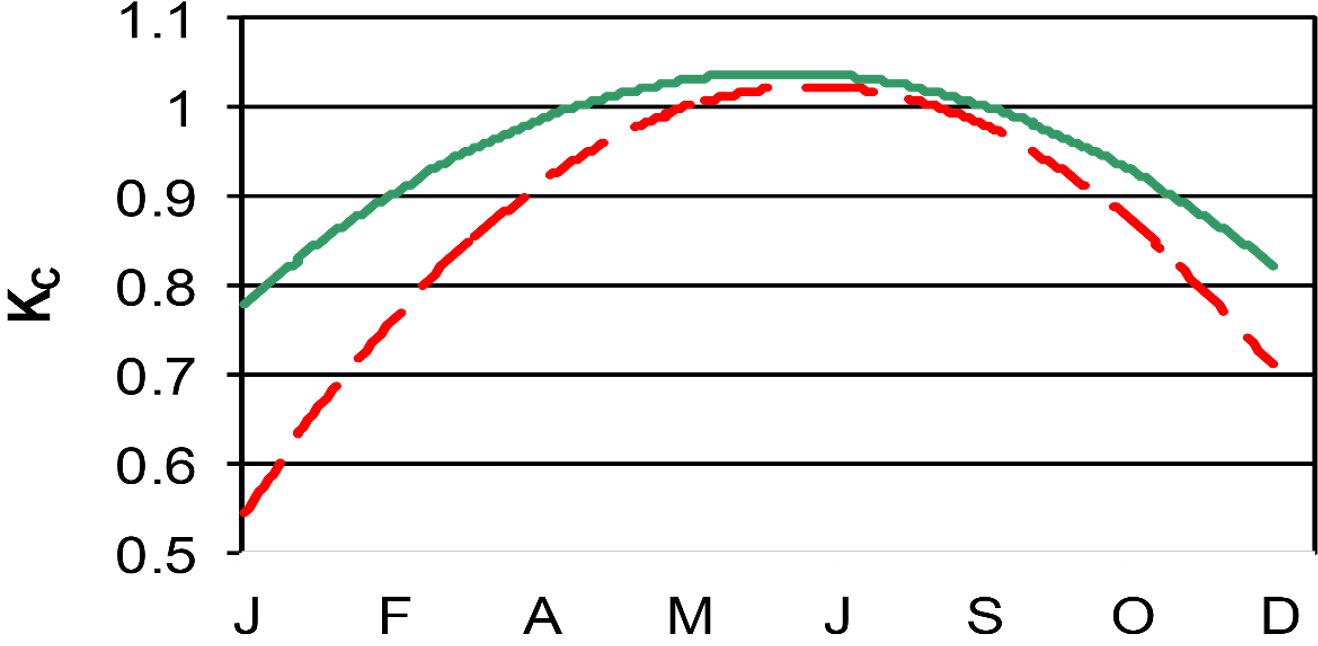
Credit: UF/IFAS
Soil Water Measurement
The use of soil moisture sensors (Figure 2) improves accuracy in determining irrigation timing and amount because they quantitatively measure changes in soil water status. These sensors may be fixed in one location, portable, or handheld. They may measure soil water at one depth or at multiple depths, in the case of soil moisture probes. General categories include time-domain reflectometry (TDR) and time-domain transmissivity (TDT) probes and frequency domain reflectometry (FDR) capacitance probes.
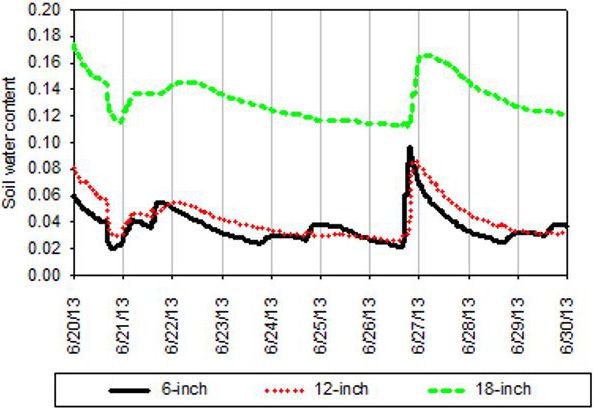
Credit: UF/IFAS
Considerations when using soil moisture sensors to schedule irrigation include the following:
- Knowing the soil water-holding capacity (or soil type) and tree root zone depth.
- Placing sensors where the majority of roots are located (typically in the top 12 inches), such as at the dripline of the tree, in an area inside of the microsprinkler or dripper wet pattern and no more than 1 ft from the canopy area.
- Using multiple sensors, both across the grove and with depth, to fully characterize the tree root zone. At least two sensors should be installed in the top 12 inches of soil.
- Basing irrigation on the soil depth containing the greatest root density.
- Managing root zone soil moisture between field capacity and the maximum allowable water depletion (one-fourth to two-thirds depletion, depending on the time of year).
Considerations for soil moisture sensor installation and management can be found in EDIS publication AE551, "Common Questions When Using Soil Moisture Sensors for Citrus and Other Fruit Trees."
Mobile Apps
Mobile smart devices (e.g., smartphones, tablets) are convenient and easy to use, making them ideal for disseminating information on a regular basis with real-time data. That is why UF/IFAS developed the Citrus SmartIrrigation app, which is free and available to download in the App Store and Play Store at no cost. The app can also be used directly from the FAWN website. A simple description of how to use the app is available at https://crec.ifas.ufl.edu/media/crecifasufledu/extension/extension-publications/2016/2016_July_app.pdf; and a quick video tutorial for installation and use is available at https://www.youtube.com/watch?v=8st9riCtyAE. Similarly, FAWN developed an app for the iPhone and Android platforms, provided as a cost share from the Florida Department of Agriculture and Consumer Services, which allows users to view data from grower-owned weather stations on their smartphones in much the same way that the data can be viewed on the FAWN webpage. By using the app instead of a set time-based schedule for irrigation, users achieve accurate irrigation. The irrigation scheduling app has the potential to reduce water and fertilizer use, resulting in reduced irrigation and fertilizer costs and the possibility of reducing nutrient leaching.
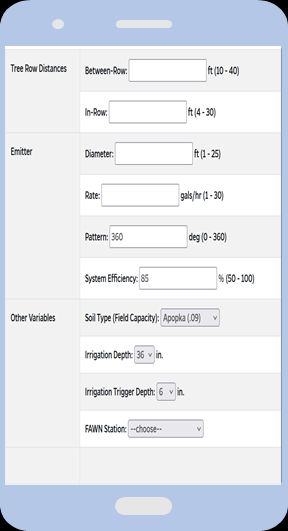
Credit: UF/IFAS
Irrigation Strategies to Improve Nutrient Uptake and Reduce Leaching
Developing an irrigation strategy to reduce nutrient leaching has the objective of not applying more water than the root zone can hold. Considering the low water-holding capacity of citrus grove soils, this objective is very challenging even for the most experienced and diligent irrigation managers. The major questions to be answered in this procedure are
- How much water can be held across the root zone?
- What is the maximum irrigation system run time before leaching occurs?
Assumptions are
- Root depth for HLB-affected trees has been reduced to about 1 ft on both the ridge and flatwoods.
- Diurnal demand for water varies during the day as temperature, relative humidity, and temperature fluctuate.
Example
We have a central ridge citrus grove with the following characteristics:
- Tree spacing—10 ft in-row × 20 ft between rows = 218 trees/acre.
- Tree canopy diameter—15 ft.
- Root zone depth—1 ft.
- One 16 GPH microsprinkler per tree with a 16-ft diameter wetted pattern.
- The citrus root zone is continuous from tree to tree, existing both inside and outside of the wetted pattern.
- The irrigated system wets approximately 60% of the total root zone (Figure 4a).
- Nutrient leaching risk in this grove is higher within the wetted pattern due to potential overirrigation, plus the fact that most fertilizers are applied to that zone (Figure 4b). Irrigation managers can control this risk by controlling irrigation using soil moisture sensors or the Citrus SmartIrrigation app.
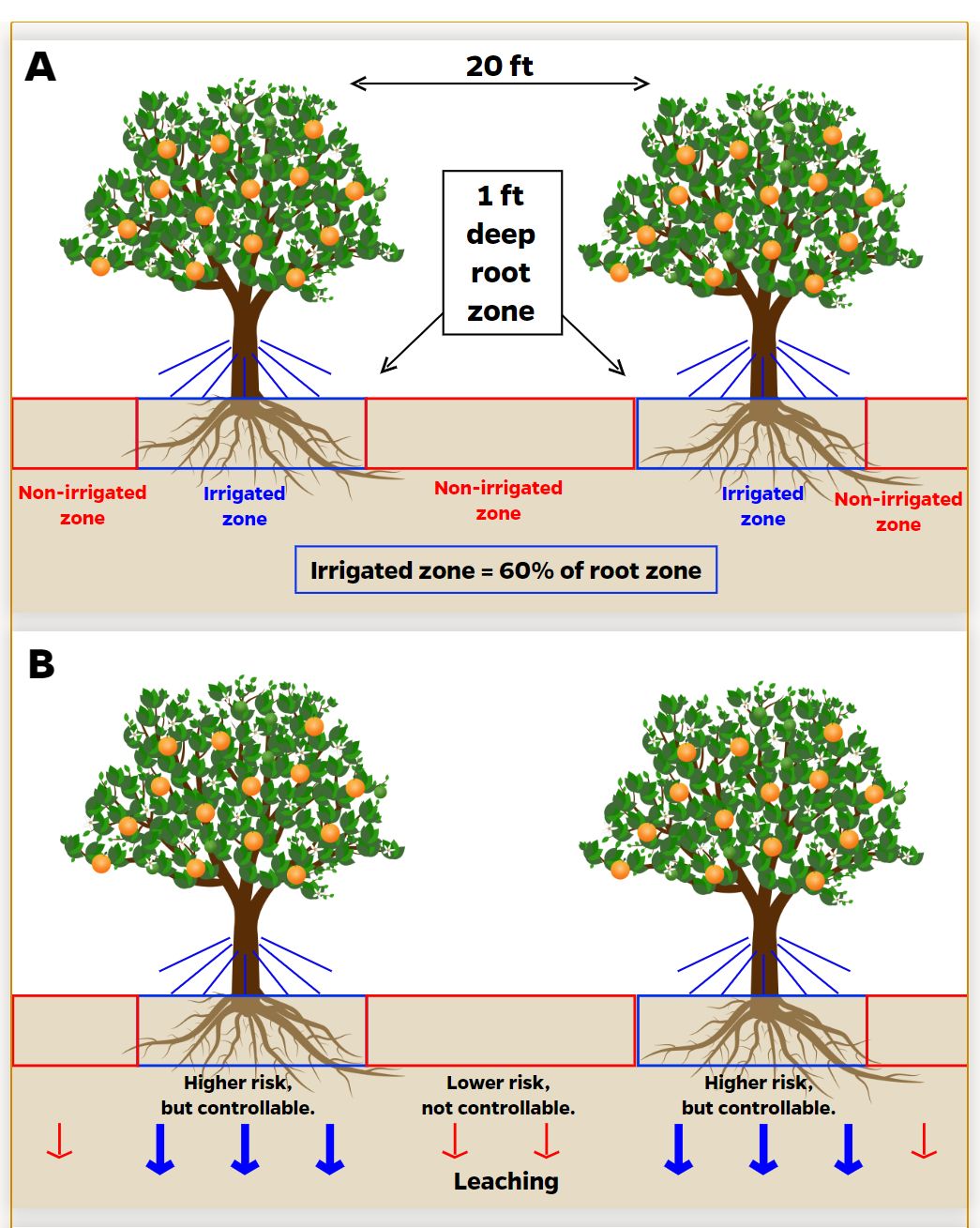
Credit: UF/IFAS
This example starts with the entire grove at field capacity moisture content following a heavy rain (Figure 5a). The citrus trees begin to remove water from the soil in response to the atmospheric ET demand. After several days have passed (depending on time of year), the water content in the root zone decreases to 50% of available water capacity (Figure 5b).
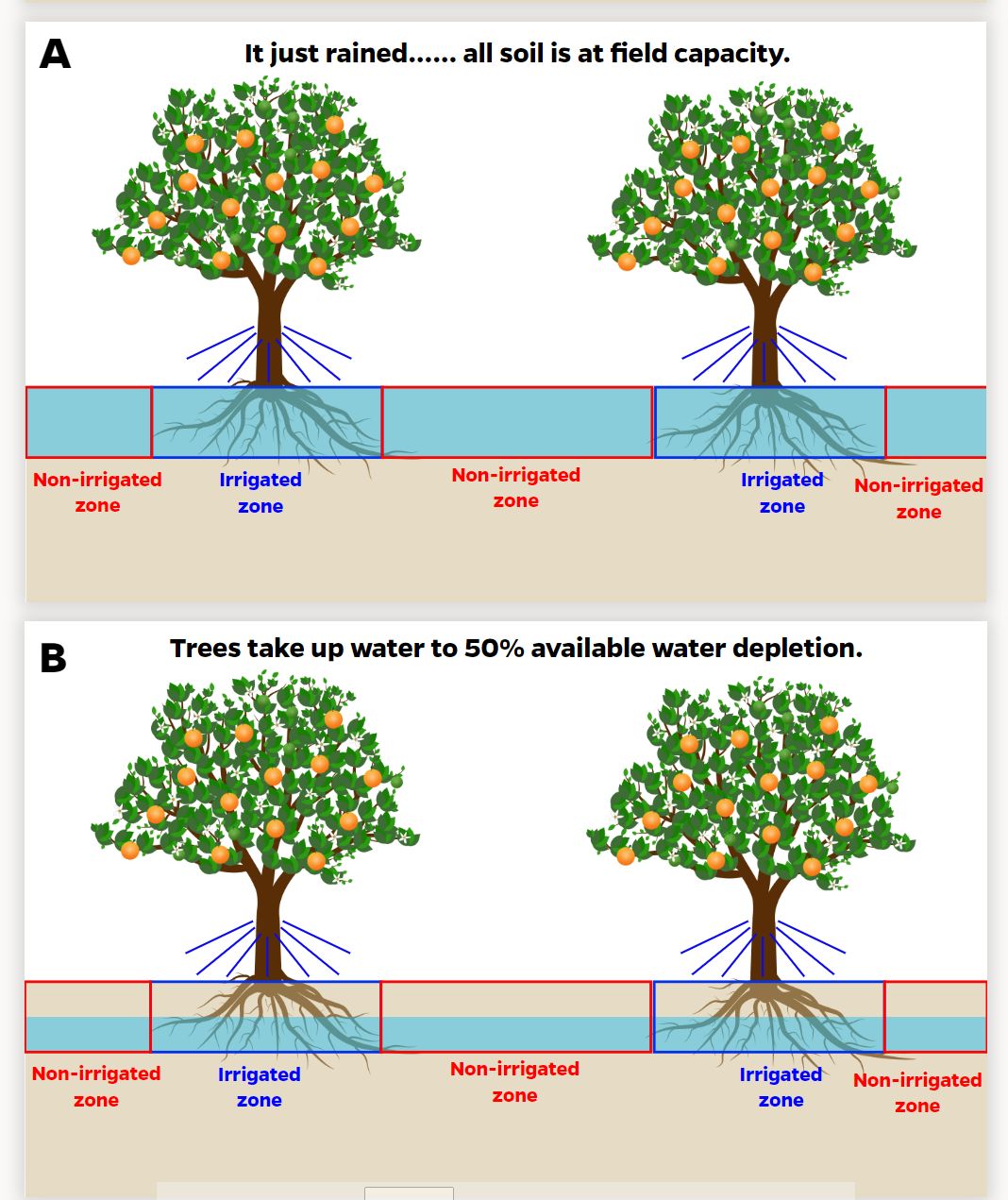
Credit: UF/IFAS
At this point, the grove manager turns on the irrigation system and operates it long enough to return the soil in the wetted pattern back to field capacity (Figure 6a). From this point until the next significant rainfall, the manager can only influence the soil water content in the irrigated zone. The water content in the nonirrigated zone rapidly decreases to the point where little to no soil water can be extracted by the trees.
If the grove manager operates the irrigation system too long and applies more water than the soil can hold, water will move beneath citrus tree roots. If water-soluble nutrients like nitrate or potassium are present in the irrigated zone during the irrigation period, a portion will leach (Figure 6b).
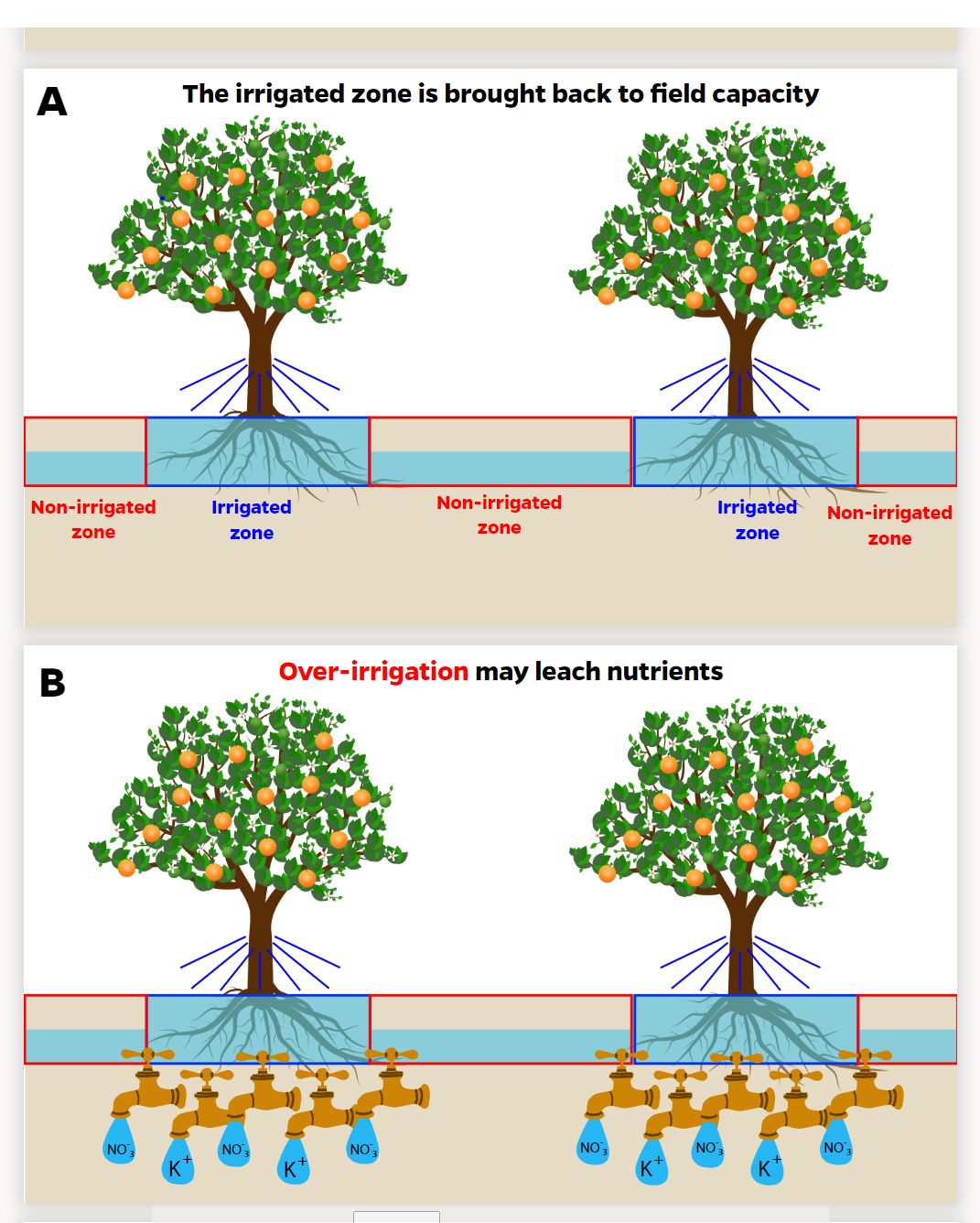
Credit: UF/IFAS
Central Ridge Soils
How much water can the root zone hold?
- Central Ridge soils—0.3 to 0.7 inches/ft
What is the maximum system run time before leaching occurs?
Calculations are shown below based on daily irrigation schedule.
Table 1. Run time.
Calculations—Summer High Water Depletion Schedule
- Volume of water the root zone can hold: 0.6 inches/ft × 1 ft deep root zone = 0.6 inches
- Volume of water to refill at maximum depletion: 0.6 inches × 10% = 0.06 inches
- Volume of water this represents per tree space: 0.06 inches/tree × 1 ft/12 inches × (20 ft × 10 ft) × 7.5 gal/ft3 × 60% coverage = 4.3 gal/tree
- Maximum system run time: 4.3 gal ÷ 16 gal/hr emitter flow rate = 0.27 hr
- Adjust for system irrigation efficiency of 90%: 0.27 hr ÷ 0.9 = 0.3 hr
Therefore, the irrigation system should never be run longer than about 0.3 hours (18 minutes) for any single cycle, provided that the available soil water is at least 10% depleted when the irrigation begins.
Flatwoods Soils
How much water can the root zone hold?
- Flatwoods soils—0.3 to 1.2 inches/ft
What is the maximum system run time before leaching occurs?
Calculations are shown below based on daily irrigation schedule.
Table 2. Run time.
Calculations—Summer High Water Depletion Schedule
- Volume of water the root zone can hold: 0.6 inches/ft × 1 ft deep root zone = 0.6 inches
- Volume of water to refill at maximum depletion: 0.6 inches × 30% = 0.18 inches
- Volume of water this represents per tree space: 0.18 inches/tree × 1 ft/12 inches × (20 ft x 10 ft) × 7.5 gal/ft3 × 60% coverage = 9 gal/tree
- Maximum system run time: 9 gal ÷ 16 gal/hr emitter flow rate = 0.56 hr
- Adjust for system irrigation efficiency of 90%: 0.56 hr ÷ 0.9 = 0.62 hr
Therefore, the irrigation system should never be run longer than about 0.6 hours (36 minutes) for any single cycle provided that the available soil water is at least 30% depleted when the irrigation begins.
Irrigation Management Considerations for HLB-Affected Trees
With HLB, irrigation scheduling is becoming more important than ever, because water stress can negatively affect tree growth and crop production.
Other benefits of proper irrigation scheduling include reduced loss of nutrients through leaching due to excess water applications and reduced pollution of groundwater or surface waters. Three studies were conducted in Florida from 2011 to 2015 with the objective of determining (1) the effectiveness of ET-based irrigation scheduling on reduced water use in citrus, (2) irrigation requirements of HLB-affected citrus trees compared with healthy trees, and (3) the effect of irrigation scheduling on productivity of citrus trees affected with HLB.
Results from the first field study indicate water use with soil moisture sensors and ET-based models reduced average monthly water use by approximately 14% of the conventional irrigation practice without reducing yields (see Notes section).
Results from a second study under greenhouse conditions indicated that healthy trees consumed approximately 25% more water than HLB-affected trees (Figure 5). Reduced water uptake by HLB-affected trees resulted in significantly greater soil water content. The relationship between leaf area and water uptake indicated that diseased trees with lower canopy density and corresponding lower leaf area index take up less water and consequently less nutrients from the soil. The elevated soil water content may partially explain higher rates of root infection with Phytophthora spp. observed in some HLB-affected trees.
The third experiment was conducted in three commercial groves on Ridge and flatwoods soils. Irrigation schedules consisted of current UF/IFAS ET-based recommendations, daily irrigation, and an intermediate schedule, all using the same amount of water on an annual basis. The UF/IFAS schedule was determined weekly using the Citrus Irrigation Scheduler found at the Florida Automated Weather Network (FAWN) website and resulted in irrigation schedules ranging from daily in May to every 10–14 days in the winter months from November to February. Daily irrigation schedules were determined by dividing the UF/IFAS irrigation duration by the number of days between irrigations. “Intermediate” irrigation was half the UF/IFAS interval for half the time. Daily irrigation increased tree water uptake and soil water content compared with Intermediate and UF/IFAS schedules. Daily and intermediate irrigation increased canopy density as measured by leaf area index compared with the UF/IFAS schedule. Fruit drop per square foot under canopy area was lower for daily irrigation schedules in the second year of the study, but yields were similar among all irrigation schedules.
This shows that for HLB-affected trees, irrigation frequency needs to be increased and amounts of irrigation water decreased to minimize water stress from drought or excess water, while ensuring optimal water availability in the root zone at all times. In addition, irrigation should be done early in the morning, preferably before 9 a.m., to optimize water uptake. Growers should seek to maintain soil moisture in the root zone (top 12 inches for both ridge and flatwoods soils) using soil moisture sensors or irrigation apps. The SmartIrrigation app provides the option of daily irrigation schedules. As noted above, HLB-affected trees with lower canopies use less water than do healthy trees. Therefore, if the irrigation scheduling app is used, the irrigation time should be reduced by 10% to 20%. For example, if the app suggests an irrigation time of 1 hour, this time could be reduced by 6 to 12 minutes for HLB-affected trees.
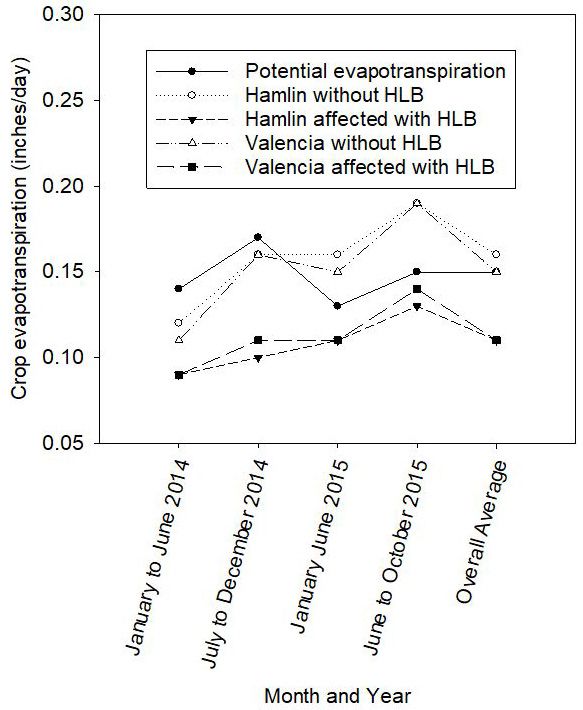
Credit: UF/IFAS
Notes
1 Figures 4 to 7 were illustrations included in SL253 chapter 9. The illustrations of water content changes in the citrus tree root zone (Figures 5 to 6) do not represent the actual water extraction pattern. The blue shading shows (1) approximately where water extraction occurs beneath the canopy, and (2) the relative soil water content with respect to available soil water-holding capacity.
2 Conventional irrigation practice for Florida citrus refers to use of microsprinkler irrigation based on replacing the citrus seasonal tree water requirements using Florida Automated Weather Network data.
Web Address for Link
Citrus Irrigation Scheduler: https://fawn.ifas.ufl.edu/tools/irrigation/citrus/scheduler/
EDIS publication AE551, "Common Questions When Using Soil Moisture Sensors for Citrus and Other Fruit Trees": https://edis.ifas.ufl.edu/publication/ae551
Nutrition of Florida Citrus Trees, Chapter 9: https://edis.ifas.ufl.edu/publication/SS676